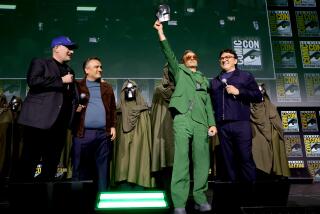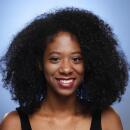What’s it like to be a woman in the Marvel Cinematic Universe? Four onscreen superheroes share their stories
Despite portraying some of the most powerful characters in perhaps the most epically realized universe ever seen on screen, the women of Marvel are still being asked about what they’re wearing.
Case in point: At the official “Avengers: Infinity War” press conference Sunday — where more than 20 Marvel stars assembled to skillfully sidestep journalists’ questions about the top-secret movie — Marvel Cinematic Universe veteran Scarlett Johansson, who plays super-spy Black Widow, was asked about the “fashion elements” of the films.
“I got the fashion question?” she asked incredulously. The crowd laughed, but the question prompted Zoe Saldana, another MCU vet, to flash back to a pop culture moment earlier this year: the sea of black dresses at this year’s Golden Globes.
In an interview later that day, the actress, who plays Gamora in the “Guardians of the Galaxy” films, said that in order for people to start talking about the Time’s Up movement, it was important to first eliminate the “ambiguous” fashion questions often asked of female actors.
“The Golden Globes really set a tone,” she said. “And for those of us that were watching through our screens at home, we were all going to lend solidarity to that statement because [being asked about fashion rather than process] is objectifying and it is absolutely wrong.”
The universe we live in may be changing ever so slowly, but the Marvel Cinematic Universe has been moving at a far swifter pace. That’s where women including Johansson, Saldana, Elizabeth Olsen and Danai Gurira now embody some of the mightiest heroes on Earth and beyond: a reformed assassin, an elite alien combatant, a reality-warping witch and a general of the world’s strongest army.
Of course, it wasn’t always that way.
“When I started out doing ‘Iron Man 2,’” said Johansson, “the main female character was Gwyneth [Paltrow]’s character, Pepper Potts. She is actually an incredibly strong female presence. And I think she sort of set the groundwork for strong female characters in the Marvel Cinematic Universe.”
But it would fall to Johansson’s Black Widow to become the first Marvel woman to truly get in on the action.
“As the female [heroes] were thankfully introduced,” Johansson began with a laugh, “I think the films now really reflect the diversity that the audience has been asking for and represent more fairly the fans that are supporting these films.”
That doesn’t mean there isn’t still room for improvement.
“The thing that would be great is if there was a bit more humor” among the female characters, said Olsen, who plays “Avengers” anti-heroine Scarlet Witch. She pointed to the positive reception of Tessa Thompson’s Valkyrie in “Thor: Ragnarok” and Pom Klementieff’s Mantis in “Guardians of the Galaxy Vol. 2” to support her argument for female characters who can both kick butt and get laughs.
“A lot of the women become these grounding forces of the storylines and bring an emotional quality and life to it,” she continued. “You can be grounded and emotional but you can also get the funny bits. We have a lot of funny, quick women, so might as well represent them.”
Along with humor, Saldana said she’d most like to see more layered female characters and complex story arcs. “There’s layers of imperfections that sometimes make a superhero even more admirable,” she said.
A sea change emerged with the introduction of “Black Panther” this year, not only for the representation of black superheroes but for the film’s strong presence of fully fleshed-out, capable women as well.
“All the female characters in ‘Black Panther’ were so well-rounded, strong, funny and present,” said Johansson. “It was really nice to see that balance. I think it finally came full circle.”
“I think ‘Panther’ was the one to really step up the game,” Olsen agreed. But beyond the Ryan Coogler-directed film, she noted that Marvel’s female characters, with few exceptions, have served a greater purpose than simply playing opposite a male lead.
“[Marvel] created them as part of the team,” she explained. “And now it’s becoming more of a focus, as opposed to just being part of the team. Now [women are] becoming part of the forefront.”
In July’s “Ant-Man and the Wasp,” Evangeline Lilly will make her debut as the MCU’s first female title character. And in March, Marvel will release its 21st entry in the franchise and the first-ever standalone film headlined by a woman: “Captain Marvel,” starring Brie Larson. It’s likely no coincidence that, following her introduction, Marvel will release the still-untitled “Infinity War” follow-up two months later.
As the unofficial first lady of the Avengers, many fans expected Black Widow to get the star vehicle honor, but Johansson says she’s happy enough with the work she’s put into the last 10 years. However, she wouldn’t rule out the chance of having her long-rumored standalone film come to fruition if it were “groundbreaking.”
“I think it’s a character who has a unique moral compass,” she said of Widow. “She’s the only Avenger … whose superpower is she’s human. Her ability to strategize, her foresight says a lot about her as a person. I think in some weird, twisted-around way she’s as altruistic as a person can really be. There’s a lot to pursue ... I want the Okoye standalone though.”
The evolution of females in the MCU from supporting characters to the forefront of the films has certainly served “Black Panther” breakout Gurira, known for her fan favorite role as warrior woman Michonne on AMC’s “The Walking Dead” and one of the newest members of the MCU. The actress, who admits she knew “very little” about Marvel before taking on the role of Okoye, was ready to collaborate with Coogler but found he already had a clear and progressive vision of how he wanted to bring the character to life.
“When I went to do the research on ‘Black Panther’ and I saw how she was originally written, I thought that was such an astounding progression,” she said. On the comic book page, the army Okoye leads, known as the Dora Milaje, were not only Black Panther’s protectors but also “wives-in-training.”
“It was like a sign of progress that you could take a character written as she was originally written and transform her into what we put on the screen. And I think that that was such an awesome thing about Ryan, about Marvel — they were taking those steps to evolve female characters into something far more dimensional and rich.”
Giving female characters equal footing in one of the most sprawling franchises in recent memory isn’t just about better, more inclusive storytelling. It also can completely change an actor’s career trajectory, Saldana says.
“The reality is that if you are a part of films that have global releases, you do become an actor that is considered an asset or of value to a production,” she said. “It puts you in a place where you have access to future roles. I think that’s a great thing.”
Olsen agrees, although she admits she has never signed one of the larger, multi-picture contracts à la franchise headliners Chris Evans and Robert Downey Jr. While her character’s longevity isn’t guaranteed, she says her association with Marvel has still allowed her to make more interesting decisions than she might otherwise.
“I think what it’s done for me is it’s allowed me to have the security of knowing when the next job was coming,” she said. “So then you’re capable of being more creative with the other choices you make.”
And it’s about time women and other underrepresented communities are allowed that same opportunity to be “bankable” as the men, Olsen said.
Marvel “has an incredible platform and reach and they know that,” she said. “So that’s why they are trying to push themselves to create ‘Black Panther’ and ‘Captain Marvel.’ What’s so lovely about working with Marvel is that they’re aware of their responsibility and they’re using it well, or at least trying to.”
“I think Marvel, from the beginning, had this much-appreciated and wonderful habit of hiring actors that never probably could’ve imagined themselves in any type of genre franchise, let alone a giant superhero action movie,” Johansson pointed out. “And that started really with the hiring of Robert Downey as Iron Man.”
She cites Mickey Rourke, Jeremy Renner, Mark Ruffalo and Don Cheadle as other examples. “And bringing [Anthony] Mackie on to do Falcon, having come off a really solid independent film career,” she continued. “I think that’s been career-changing for all of us. It takes you out of the box or whatever pigeonhole you’ve been placed into and gives you so many more possibilities to make films that probably would never see the light of day. That’s the gift that being ‘bankable,’ in quotes, gives you.”
And one of the benefits of being “bankable” is that it puts you in a position of being able to demand more things, including inclusion riders. Saldana says she is grateful to Frances McDormand for introducing the term to the public during her rousing Academy Awards speech.
“It made us all look into the true meaning of what that will entail for us if we decide to be bold and brave,” she said. “Which, I think I will do. And demand that my lawyers include that clause in my contract so I make sure I’m contributing to that.”
“I think Marvel is trend-setting in every other way and one thing I know about Kevin Feige is that he doesn’t want to be behind,” said Johansson. “I think that everyone that’s headlining the standalone films should insist on it. And I hope that [Marvel executives] take charge so it doesn’t have to befall any one actor’s shoulders to do that, it can just be a corporate policy.”
While the future looks bright, Saldana remains grateful for an opportunity to discuss more than fashion for a change.
“It just keeps going in the right direction,” she said. “I love, besides just talking about Black Widow’s hair color at every sequel, we’re talking about all these other things.”
follow me on twitter @sonaiyak
More to Read
Only good movies
Get the Indie Focus newsletter, Mark Olsen's weekly guide to the world of cinema.
You may occasionally receive promotional content from the Los Angeles Times.











